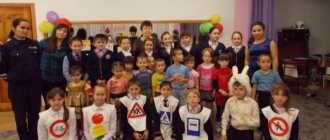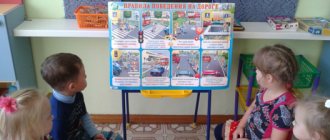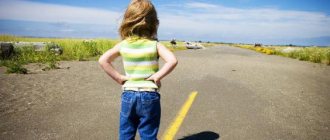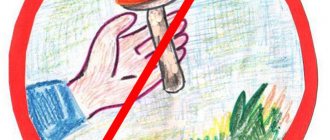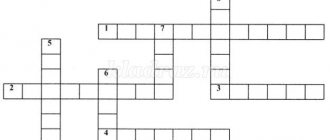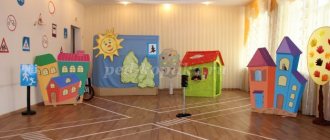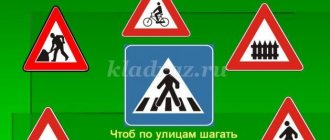Conversation on traffic rules in a preschool educational institution. Senior group
Topic: “Public transport” for children of senior preschool age. Purpose: this material will help organize a conversation on traffic rules with preschoolers, and will also be useful to educators and parents. Prepared by: Chekhovskaya Elena Rashidovna, teacher of the first qualification category, MBDOU No. 28, Shakhty, Rostov region.
Goal: To introduce the rules of a road user, broaden one’s horizons, give an idea of the dangers on the road - to teach a child to live and act in real life, to become familiar with the rules of behavior in public transport and outside it. Objectives: - to give an idea of the distinctive features of public transport, - to expand knowledge about the rules of behavior on the road, - to teach how to be educated passengers in public transport, - to cultivate responsibility for one’s life. Progress of the conversation. -We begin our journey to the country of road literacy. — What is traffic rules? (Road rules.) - Why is it necessary to know the rules? — How do you understand the words “dangerous situation on the road”? -What could be the cause of “dangerous situations on the road”? — Traffic rules are a road map. Everyone should own one to prevent accidents. Game "Answer quickly and correctly."
The inspector-teacher asks the children various questions related to road safety. (The game can be repeated several times.) 1. What parts does the street consist of?
(Sidewalks, roadways, intersections) 2. Where can people walk? (On the sidewalk) 3. Where can you cross the street? (At pedestrian crossings) 4.What pedestrian crossings do you know? (ground, underground, overground) 5. When you cross the road at a zebra crossing, where should you look first? (To the left, and in the middle - to the right.) 6. What does a pedestrian crossing indicate? (Traffic light, zebra crossing, road sign.) 7. At what traffic light can you cross the road? (On green.) Awarding the best children with prizes. Problem message. Today we will talk about transport on city streets. Transport exists for the rapid movement of people over short and long distances. - What is it called?
Public transport is a vehicle designed to transport a large number of passengers that runs along certain routes. As soon as we buy a ticket for any type of public transport, we are passengers.
Guess the riddles.[/
b] 1. Doesn’t fly, doesn’t buzz, The beetle is running down the street. And two brilliant lights burn in the beetle’s eyes. (Car) (M. Doroshin.)
2. The house goes down the street, taking everyone to work. Not on thin chicken legs, but in rubber boots. (Bus.) (M. Doroshin.)
-Find the similarities and differences between a car and a bus.
(big, small, many passengers. Buses and cars pollute the air with exhaust gases - this is very bad.) -Where do people use such public transport? Physical education
We rode a horse, got to the corner, got into the car, poured gasoline. We drove by car and reached the river. Trrr! Stop! U-turn. We need to get on the plane. The plane is flying, the engine is humming: -U-U-U! 3. Early in the morning outside the window - Knocking and ringing and chaos: Red houses walk along straight steel paths. (Tram.)
-Tram is an electric rail public transport. It has an arc on the roof that moves along an electrical wire located at the top. The current flows through the arc to the tram engine, and through the engine to the wheels. — What is the difference between a tram and a bus? — Where do people use such transport? 4. Amazing carriage! Judge for yourself: The rails are in the air, and he holds them with his hands! (Trolleybus.)
— How does a trolleybus differ from a tram?
What common? — Where do people use such transport? — What should a driver of any public transport be like? (attentive, experienced, knowledgeable, smart, healthy, polite.) Rules of conduct for passengers in public transport.
— Tell us about the rules of behavior at a bus stop, in transport? (Don’t linger in the aisle. Pay the fare. Don’t litter, don’t make noise, don’t distract the driver. Don’t lean out of the windows of the transport. Give up your seat to older people, passengers with children.) - How should you enter public transport? (Through the back door.) - How should you get out of the vehicle? (Through the front door.) How to get around public transport? Remember! A stationary tram is bypassed from the FRONT! Bus and trolleybus - BACK!
Role-playing game “We are passengers.”
Goal: to consolidate the rules of behavior for passengers at a bus stop, in transport, when exiting a transport. — Let's distribute the roles: driver, pedestrians, passengers, inspector. (Make transport out of chairs in advance.) - Boarding the bus. — Disembarking passengers and walking around the bus. (Trolleybus, tram.) Result of the conversation. — What happens if we violate the rule of bypassing traffic? Our journey to the land of the road map is over.
We recommend watching:
Leisure time in the senior group on traffic rules Scenario of a speech by a propaganda team on traffic rules for children of the senior group Conversation in the senior group on the topic: Traffic rules Lesson summary for children 5-7 years old “Travel according to traffic rules”
Similar articles:
Summary of a lesson on traffic rules in the senior group in kindergarten. Rules for pedestrians and passengers
Summary of a lesson on traffic rules in the senior group in kindergarten. Types of traffic signs. Warning road signs
Summary of a lesson on traffic rules in the senior group of kindergarten. Rules for cyclists
Tasks on traffic rules for preschoolers in pictures
Parent meeting on traffic rules in kindergarten
Conversation with children “Dangerous Road”
Goal: To warn children about possible life-threatening dangers that may occur on the street ( road )
Objective: to teach children to assess the seriousness of the road situation.
Methodological manual: thematic cards with traffic situations, road signs, traffic lights.
– Guys, the topic of today’s conversation is “ Danger on the roads ”
. The first thing you should remember:
The best way to save your life on the roads is to follow the traffic rules.
One of the most important rules says:
When crossing the street, you must first look to the left, and when you reach the middle of the road, look to the right.
You can cross the street only at pedestrian crossings marked with a special “Pedestrian Crossing”
.
Even at pedestrian crossings, stripes are drawn on the asphalt; they are called “zebras.”
. Many people die when they cross the street incorrectly.
For pedestrians, traffic lights have their own signals: red man - wait; green man - go. And if you go to a green light for cars, you can easily get hit by a car going around a turn.
You cannot cross the street at a red light, even if there are no cars.
Shortly before the end of the green traffic light, the green light usually begins to flash.
If you do not have time to complete the transition to a green light, do not try to pass in front of moving cars. Wait calmly on the median in the middle of the road until the light turns green.
When crossing the street when the light is green, just in case, look first to the left, then to the right.
If the pedestrian light is green and you see a car approaching with its siren on, wait for it to pass. "Ambulance"
, fire, police and some other vehicles have the right to drive even at a red light.
Do not stand at the edge of the sidewalk while waiting for the green signal. Because you may be accidentally pushed onto the road.
When there is no crossing on the road, you can cross it under two conditions:
if the road is clearly visible in both directions;
when the distance between a pedestrian and an approaching car is not less than the distance between three lamp posts.
Under no circumstances should you run out onto the road. Even if you are in a hurry, you should slow down before the road, looking to see if a car is approaching.
Do not rush to cross the road in front of a slowly moving car. You may not see another car behind it, going at high speed.
Be careful on the road!
Take care of your arms and legs,
follow traffic rules,
Otherwise there will be trouble!
Conversation on the topic: “Road and children”
Conversation on the topic: “Road and children”
Purpose of the conversation: Activation of children's activities to teach the rules of safe behavior on the roads and the prevention of children's road traffic injuries.
All activities carried out are aimed at: 1. Expanding children’s knowledge about the rules of behavior on the road and the ability to apply the acquired knowledge about the rules of the road in games and in everyday life. 2.Uniting the efforts of teachers and parents to familiarize children with the rules of the road and their observance in life. 3.Development of visual materials that have a developmental and cognitive impact on children
Objectives : Generalize and expand children's knowledge about traffic rules. To develop the psychophysiological qualities of the child, ensuring his safety in the process of road traffic. Foster patriotic feelings for your hometown. Instill responsibility for the safety of your life and the lives of other people. Reinforce the need to comply with traffic rules.
Progress of the conversation:
Hello guys! Today we will talk to you about what you need to do to save your life on the roads. Do you know? That's right, you need to follow the traffic rules. Let's remember them all. Rule #1. Where can you cross the road? That's right, you can only cross the road at pedestrian crossings. They are marked with a special “pedestrian crossing” sign. Look here (shows a sign). Guys, do you know what is the safest crossing? This is underground. It is designated like this (shows a sign). Rule #2. If there is no underground crossing, you must use a crossing with a traffic light. Do you know the traffic lights? Right. "Red man" means "stop!" and "green man" means "go!" Rule No. 3. You cannot cross the road at a red light, even if there are no cars. Rule #4. When crossing the road, you should always look both ways. Where should we look first? Yes, first go left, and when you reach the middle of the road, go right. Rule #5. It is safest to cross the road with a group of pedestrians. Even stray dogs who do not know the rules of the road understand this. Under no circumstances should you run out onto the road. You have to stop before the road. Guys, why can’t you run out onto the road? Can you play on the road? Why? Right. This is rule number 6. You cannot play on the roadway or on the sidewalk. Guys, if your parents have forgotten which side you need to go around a bus, trolleybus and tram, you can remind them that: A bus and a trolley bus at a stop should only be bypassed from behind, and a tram can only be bypassed from the front. Agreed? Well done guys! Remember all the rules. This is cool!
Game “Think - Guess!” Objectives: to activate the processes of thinking, attention and speech of children; clarify your understanding of transport and traffic rules; cultivate intelligence and resourcefulness. Rules: you must give the correct answer and not shout it out in unison. The one who gets more chips for correct answers wins. I will ask you questions. Anyone who knows the correct answer should raise their hand. Whoever answers correctly first gets a chip. At the end of the game we will count the chips and reveal the winner.
Questions: - How many wheels does a car have? (4) — How many people can ride one bike? (1) - Who walks on the sidewalk? (pedestrian) - Who is driving the car? (Driver) - What is the name of the place where two roads intersect? (Intersection) - What is the roadway for? (for traffic) - On which side of the roadway is traffic moving? (On the right) - What can happen if a pedestrian or driver violates traffic rules? (Accident or traffic accident) - What is the top light at the traffic light? (Red) - At what age are children allowed to ride a bicycle on the street? (from 14 years old) - How many signals does a pedestrian traffic light have? (Two) - How many signals does a pedestrian traffic light have? (Three) - What animal does a pedestrian crossing look like? (At the zebra crossing) - How can a pedestrian get into the underground passage? (Down the stairs) - If there is no sidewalk, where can a pedestrian move? (On the side of the road on the left, towards traffic) - Which cars are equipped with special sound and light signals? (“Ambulance”, fire and police vehicles) - What is the traffic police inspector holding in his hand? (Rod) - Where should you play so as not to be in danger? (In the yard, on the playground)
Carefully! Road! (conversation on traffic rules)
Conversation
"Carefully! Road!"
Tasks:
- Consolidation of knowledge on traffic rules and safety on roads and in transport;
- Fostering a culture of behavior on the road and in transport, in order to prevent child road traffic injuries.
Progress of the event:
1. Introduction (introductory speech by the class teacher). Compliance with traffic rules is the law of preserving life. One cannot but agree with this. However, statistics say: approximately three quarters of all road accidents involve children. Let's think about what these reasons might be. The most common are: -Crossing the roadway outside the designated crossing areas. -Unexpected exit due to moving or stationary vehicles or other obstructions that obstruct the view. -Disobeying traffic lights. -Games on the roadway and walking along it if there is a sidewalk. How can you protect yourself from rash actions on the road? How to prevent an increase in road accidents involving schoolchildren? To do this, it is necessary to attach great importance to the topic of security. And we'll talk about this today.
2. Main part (Conversation with the class).
Imagine that all the traffic lights in our city suddenly went out. And all the inspectors regulating traffic have disappeared somewhere. What consequences might there be? (Discussion of the issue). Every day more and more cars appear on our roads. High speeds and traffic volumes require drivers and pedestrians to be very careful. Discipline, caution and compliance with traffic rules by drivers and pedestrians are the basis for safe movement on the street. What is a traffic accident? (Discussion of the issue by students). Of the total number of road traffic accidents, half involve pedestrians. This is a terrible indicator, indicating the low culture of both pedestrians and drivers. It turns out that pedestrians do not have the patience to wait for the right moment to cross the road. Half are willing to stand on the sidewalk for just 4 seconds, while the fifth are willing to risk their lives to end up on the opposite side of the road. We must fight such impatience, remembering that the one who “hurries slowly” comes first. A striped path (“zebra”) only to some extent guarantees your safety on the road. Scientists have found that seven out of ten drivers who are busy talking on a cell phone will not give way to pedestrians at a zebra crossing. Today we will try to figure out what we are doing wrong on the road. Let's start with the most common vehicle available to schoolchildren - a bicycle. Let's remember the first thing: this is the most unprotected vehicle. It does not have doors that protect against side impacts, and there is no bumper that would partially absorb a frontal impact. Therefore, in any collision or collision with an obstacle, the cyclist is very vulnerable. Second: it is comfortable to ride a bicycle where a special safe zone has been created for this. Third rule: never try to pass between a moving and a stationary car. Stop and let the car coming towards you pass. Don't take this as cowardice, it's just common sense. Now the main thing: try not to drive onto the roadway, even if you are over 14 years old. You can ride a moped on the roadway from the age of 16. But remember: you should only move in the far right lane, in one row, as far to the right as possible. The relative safety zone ends further than one meter from the sidewalk.
3. Consolidation of what has been learned (in a playful way).
3.1.Answers to questions:
-The roadway is paved. (Highway). -A person traveling in a vehicle. (Passenger). -A person moving on foot. (A pedestrian).
-It can be prohibitive, permissive, or informational. (Sign)
-The strictest road signs. (Prohibiting).
-Who should know road signs? -Waiting place for the bus. (Stop). -Vehicles powered by electricity. (Trolleybus, tram). -Emergency telephone number. (03). -A place where you leave your transport for a while. (Parking). -Multi-seater vehicle for transporting passengers. (Bus). -Path along the road, not for cars. (Sidewalk). -This happens to those who do not follow traffic rules. (road accident). -The most dangerous place for pedestrians. (Crossroads). -Rule breakers are afraid of him. (Inspector). -How is a pedestrian crossing marked on the carriageway of streets and roads?
-Pedestrian crossing is different. (Zebra). -In what places are pedestrians allowed to cross the street? -What rules of behavior in public transport do you know? -What is the procedure for boarding and exiting the bus? (they walk around the bus from behind)
-How should you cross the street or road correctly? -Is it possible to run across the street or road? -Why are pedestrians not allowed to walk along the roadway? -How many signals does a pedestrian traffic light have? -Which direction should you look when you reach the middle of the street? -Stowaway? -Road for a tram? -House for a car?
-Three-eyed guard. (Traffic light).
-What pedestrian traffic lights do you know, what do they mean?
-This is the yellow traffic light “saying”. (Attention).
3.2.Game.
And now we will play a little, and at the same time we will consolidate the theory. I offer you a game for your attention. I will show traffic lights. If red means you stand still, yellow means you clap your hands, green means you go to the other side of the class. So, pay attention!
3.3.Riddles: It will oblige us to drive quietly, A close turn will show And remind you of what and how you are on your way... (Road sign).
What is this zebra crossing on the road? Everyone stands with their mouths open. They are waiting for the green light to blink, so this means... (Transition).
A three-eyed scarecrow on one leg stood from the edge of the street in a long boot. Where cars move, Where paths converge, Helps people cross the road. (Traffic light).
Drinks gasoline like milk, can run far. She carries cargo and people. You are familiar with her, of course. He wears shoes made of rubber, called... (Machine).
3.4. "Inverted Words"
Here are words in which the letters are reversed. Try to restore them to their normal order (written on the back of the board).
For example, MAIZ - WINTER
SHYAMNA –
REVOSTOF –
KHOREDEP –
NIPSKERTO –
3.5. "Find the odd one out"
Look carefully at the rows of words. Three of them are related to each other in some way, and the fourth is different. Find the extra word (orally together):
a) Bicycle, bus, motorcycle, tram.
b) “Zhiguli”, “Zaporozhets”, “Volga”, “KAMAZ”.
c) Red, blue, green, yellow.
d) Traffic rules, traffic police, traffic police, housing and communal services.
3.6. "Unravel the phrases."
Guess what phrases are hidden under the numbers:
A-1, B-2, V-3, G-4, D-5, E-6, Zh-7, I-8, J-9, L-10, N-11, O-12, P- 13, R-14, S-15, T-16, U-17, Sh-18, L-19, Yu-20, Ya-21.
16, 8,18,6 6,5,6,18,19 – 5,1,10,19,18,6 2,17,5,6,18,19.
(The quieter you go, the further you'll get).
15,12,2,10,20,5,1,9,16,6 13,14,1,3,8,10,1 5,12,14,12,7,11,12,4,12 5,3,8,7,6,11,8,21!
(Follow traffic rules!).
4. Conclusion: today we learned how to behave while driving a bicycle. We remembered the main rules for driving this vehicle on the roads and in the courtyards of our city; remembered and reinforced the basic rules of the road. We understood the main thing - you shouldn’t expose your life to unjustified risk. Following traffic rules and being careful on the road is not cowardice, but smart calculation.
